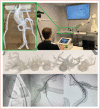Latest Developments in Robotic Percutaneous Coronary Interventions
- PMID: 38213745
- PMCID: PMC10782427
- DOI: 10.15420/icr.2023.03
Latest Developments in Robotic Percutaneous Coronary Interventions
Abstract
Since the first robotic-assisted percutaneous coronary intervention procedure (R-PCI) was performed in 2004, there has been a steady evolution in robotic technology, combined with a growth in the number of robotic installations worldwide and operator experience. This review summarises the latest developments in R-PCI with a focus on developments in robotic technology, procedural complexity, tele-stenting and training methods, which have all contributed to the global expansion in R-PCI.
Keywords: Robotic percutaneous coronary intervention; radiation; simulation; technology.
Copyright © The Author(s), 2023. Published by Radcliffe Group Ltd.
Conflict of interest statement
Disclosure: RM has received grants, consulting fees, speaker fees and travel expenses for meetings from Corindus. EF and EW have received consulting fees from Siemens and Corindus Vascular Robotics. AZH and DD have received speaker fees from Siemens. RB has holds stocks in Cordiguide, Medhub AI and Cardiac Success. AZ has received a grant from Siemens and Corindus Vascular Robotics. All other authors have no conflicts of interest to declare.
Figures





References
Publication types
LinkOut - more resources
Full Text Sources
Miscellaneous

